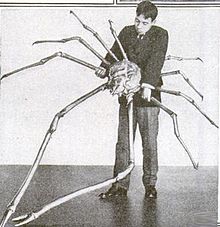- Japanese spider crab
-
Japanese spider crab 
Scientific classification Kingdom: Animalia Phylum: Arthropoda Subphylum: Crustacea Class: Malacostraca Order: Decapoda Infraorder: Brachyura Superfamily: Majoidea Family: Inachidae Genus: Macrocheira
De Haan, 1839Species: M. kaempferi Binomial name Macrocheira kaempferi
(Temminck, 1836)Synonyms [1] - Maja kaempferi Temminck, 1836
- Inachus kaempferi (Temminck, 1836)
- Kaempferia kaempferi (Temminck, 1836)
The Japanese spider crab (
高脚蟹 takaashigani, lit. "tall-footed crab"), Macrocheira kaempferi, is a species of marine crab that lives in the waters around Japan. It has the largest leg span of any arthropod, reaching up to 3.8 metres (12 ft) and weighing up to 41 pounds (19 kg). It is the subject of small-scale fishery.Contents
Description
The Japanese spider crab has the greatest leg span of any arthropod, reaching 3.8 metres (12 ft) from claw to claw. The body may grow to a size of 40 centimetres or 16 inches (carapace width) and the whole crab can weigh up to 41 pounds (19 kg).[2] It is the males which have the longest chelipeds;[3] females have much shorter chelipeds, which are shorter than the following pair of legs.[4] Apart from its outstanding size, the Japanese spider crab differs from other crabs in a number of ways. The first pleopods of males are unusually twisted, and its larvae appear primitive.[1] The crab is orange, with white spots along the legs.[5] It is reported to have a gentle disposition "in spite of its ferocious appearance".[5]
Distribution
Japanese spider crabs are mostly found off the southern coasts of the Japanese island of Honshū, from Tokyo Bay to Kagoshima Prefecture. Outlying populations have been found in Iwate Prefecture and off Su-ao in Taiwan.[4] Adults can be found at depths of up to 600 metres (2,000 ft), or as shallow as 50 metres (160 ft).[4]
Life cycle
In its natural habitat, the Japanese spider crab feeds on shellfish and animal carcasses and may live for up to 100 years.[5] Development of the planktonic larvae is temperature dependent and takes between 54 and 72 days at 12–15 °C (54–59 °F).[6]
Taxonomic history
The Japanese spider crab was originally described in 1836 by Coenraad Jacob Temminck under the name Maja kaempferi, based on material from Philipp Franz von Siebold collected near the artificial island Dejima.[7] The specific epithet commemorates Engelbert Kaempfer, a German naturalist who lived in Japan from 1690 to 1692 and wrote about the country's natural history.[8] It was moved to the genus Inachus by Wilhem de Haan in 1839, but placed in a new subgenus, Macrocheira. That subgenus was raised to the rank of genus in 1886 by Edward J. Miers.[1] Although currently placed in the family Inachidae, M. kaempferi does not fit cleanly into that group, and it may be necessary to erect a new family just for the genus Macrocheira.[1] As well as the single extant species, four species belonging to the genus Macrocheira are known from fossils.[9]
Fishery
Temminck, in his original description, noted that the crab was known to the Japanese for the serious injuries it can cause with its strong claws.[3] Nonetheless, the Japanese spider crab is "occasionally collected for food";[10] a total of 24.7 tonnes (54,000 lb) was collected in 1976, but only 3.2 tonnes (7,100 lb) in 1985.[6] Fishery is centred around Suruga Bay, and the population has decreased in number, forcing fishermen into exploring deeper waters in order to catch them. The average size caught by fishermen is a leg span of 1.0–1.2 metres (3 ft 3 in–3 ft 10 in).[7]
See also
- Largest arthropods
- Spider crab (disambiguation)
- Fauna Japonica
References
- ^ a b c d Peter K. L. Ng, Danièle Guinot & Peter J. F. Davie (2008). "Systema Brachyurorum: Part I. An annotated checklist of extant Brachyuran crabs of the world" (PDF). Raffles Bulletin of Zoology 17: 1–286. http://rmbr.nus.edu.sg/rbz/biblio/s17/s17rbz.pdf.
- ^ Maurice Burton & Robert Burton (2002). "Spider crab". International Wildlife Encyclopedia (3rd ed.). Marshall Cavendish. pp. 2475–2476. ISBN 9780761472667.
- ^ a b G. F. Mees (1957). "Over het belang van Temminck's „Discours Préliminaire" voor de zoologische nomenclatuur [On the importance of Temminck's "Discours Préliminaire" for zoological nomenclature]" (in Dutch). Zoologische Mededelingen 35 (15): 205–227. http://www.repository.naturalis.nl/document/149787. "on dit, que ce Crustacé est redouté des habitants par les blessures graves, qu'il est en état de faire au moyen de ses fortes serres"
- ^ a b c "Macrocheira kaempferi". Crabs of Japan. Marine Species Identification Portal. http://species-identification.org/species.php?species_group=crabs_of_japan&menuentry=soorten&id=857&tab=beschrijving. Retrieved March 29, 2010.
- ^ a b c "Japanese Spider Crabs Arrive at Aquarium". Oregon Coast Aquarium. http://www.aquarium.org/JapaneseSpiderCrabs.asp. Retrieved March 29, 2010.
- ^ a b Kazutoshi Okamoto (1993). "Influence of temperature on survival and growth of larvae of the giant spider crab Macrocheira kaempferi (Crustacea, Decapoda, Majidae)" (PDF). Nippon Suisan Gakkaishi 59 (3): 419–424. http://rms1.agsearch.agropedia.affrc.go.jp/contents/JASI/pdf/society/51-2165.pdf.
- ^ a b "The Japanese Giant Spider Crab - Macrocheira kaempferi - Taka-ahi-gani". Natural Art. http://www.naturalart.be/Mainpages/Articles/JGSC.htm. Retrieved March 29, 2010.
- ^ Hans G. Hansson. "Engelberg Kaempfer". Biographical Etymology of Marine Organism Names. Göteborgs Universitet. http://www.tmbl.gu.se/libdb/taxon/personetymol/petymol.k.html. Retrieved March 29, 2010.
- ^ Sammy De Grave, N. Dean Pentcheff, Shane T. Ahyong et al. (2009). "A classification of living and fossil genera of decapod crustaceans" (PDF). Raffles Bulletin of Zoology Suppl. 21: 1–109. http://rmbr.nus.edu.sg/rbz/biblio/s21/s21rbz1-109.pdf.
- ^ Kent E. Carpenter & Volker H. Niem, ed (1998). "Majidae" (PDF). The Living Marine Resources of the Western Central Pacific. Volume 2: Cephalopods, crustaceans, holothurians and sharks. FAO Species Identification Guide for Fishery Purposes. Food and Agriculture Organization. pp. 1136–1137. ISBN 92-5-104052-4. ftp://ftp.fao.org/docrep/fao/009/w7192e/w7192e33.pdf.
External links
External identifiers for Macrocheira kaempferi EOL 3103113 WoRMS 346131 Also found in: Wikispecies, ADW  Media related to Macrocheira kaempferi at Wikimedia Commons
Media related to Macrocheira kaempferi at Wikimedia Commons Data related to Macrocheira kaempferi at Wikispecies
Data related to Macrocheira kaempferi at Wikispecies
Categories:- Majoidea
- Crustaceans of Japan
- Indo-Pacific crustaceans
- Animals described in 1836
Wikimedia Foundation. 2010.

